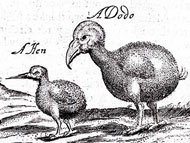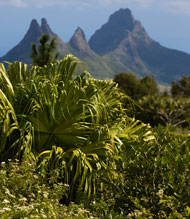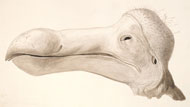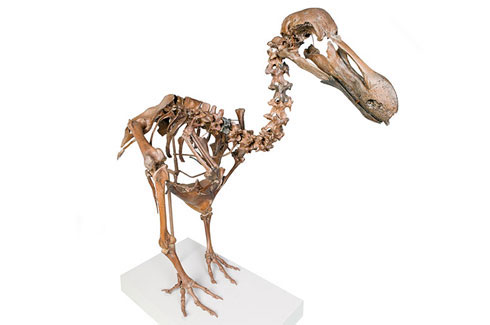Dodo skeleton
The dodo is an icon of extinction, one of the first widely acknowledged cases of a species being wiped out by humans. There are so few complete dodo skeletons that we may never know exactly what they looked like or how they lived. This Natural History Museum specimen is a composite made from bones from different individuals.

Detail from an engraving by Sir Thomas Herbert, 1634, showing a dodo (right).
Curious creatures
Dodos disappeared so quickly, they left little evidence of their existence. 150 years after they vanished, some naturalists claimed they were mythical creatures invented by sailors. Others struggled to interpret the meagre bones left behind.
We now know that dodos evolved from a pigeon species that arrived on the Mascarene Islands in the Indian Ocean more than 26 million years ago.
With abundant food and no predators, the birds had no reason to leave this island paradise. Over the years their descendants slowly grew bigger and heavier, their beaks grew larger and their wings smaller.

Mascarene island of Mauritius, once home of the dodo. © Martin Child / The Image Bank / Getty Images
Death of the dodo
Life was good for dodos living on the isolated Mascarene island of Mauritius. Until Dutch sailors arrived in 1598.
Some dodos fell prey to sailors looking for a change in diet, others to the rats, cats, pigs and monkeys the sailors brought with them. The birds themselves may have gone hungry as the invaders cleared forests that had been rich in fruits.
Just 90 years later dodos were extinct.
Devious determination
Examining the inadequate evidence available, some scientists suggested dodos were related to cuckoos, others to chickens, ostriches, penguins, cranes or eagles. Even Richard Owen, an expert taxonomist (person who identifies, names and groups organisms) was convinced they were descended from vultures.

Dodo specimen illustration by Richard Owen, 1848.
Owen was so determined to be the first to solve the mystery he resorted to devious means. He heard that some rare dodo specimens were on their way to a potential rival, and had them intercepted.
The bones joined the collections of this Museum, and in 1866 Owen became the first person to publish a scientific description of the dodo's anatomy.
Further information
- Visit this rare dodo skeleton in our new Treasures Cadogan Gallery.
- Watch a video about Richard Owen's efforts to reconstruct the dodo, and why the classic image is wrong.
- Discover other tragic cases of human-caused extinctions.
- Join Museum scientist Julian Pender Hume to explore the world of the dodo and efforts to restore it.
Vote for your favourite treasure
Is this your favourite Museum treasure? Let us know by voting in our poll.
